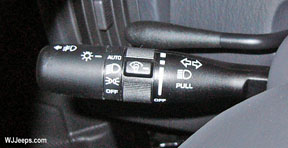Troubleshooting - Headlamps
AUTO HEADLIGHTS CYCLE ON AND OFF WHEN THE VEHICLE IS PARKED AND TURNED OFF
(with headlamp switch in "Auto" mode)
The problem is most prominent on 1999-2001 WJ's, but it could apply to the 2002-2004 WJ's. The problem could be in the switch. The switch is a multiplexed circuit, the resistance of the HEADLIGHT ON position is very close to the AUTO position; the switch has been updated to correct this problem.
NO TIME DELAY WHEN THE HEADLIGHT SWITCH IS IN THE AUTO MODE, THE LIGHTS TURN OFF IMMEDIATELY
The headlights work fine, also the TIME DELAY will work fine if the headlight switch is in the ON mode and the key id turned off then the headlight switch is turned off. The only problem is that the AUTO HEADLIGHTs will not acticate the time delay when the ignition is turned off. Also the AUTO headlights work fine (turn on when dark outside). This case is not to be confused with any other headlight issue.
The most likely cause if this unique problem is usually do to erroneous voltage on one of the TWO ignition feeds going to the bcm. Please check to see if there is any aftermarket equipment (like a radio). If there is aftermarket equipment, please unplug the component then test. If not then use a dvom and apply it to the BCM ignition feeds and closely monitior the voltage when the key is turned off, the voltage on both RUN circuits should drop to ZERO volts as soon as the key is turned off. If not, then this problem with the AUTO HEADLIGHTS can be caused by aftermarket equipment.
When the ignition is turned off, the voltage on the ignition circuits does not totally go away, in turn the bcm thinks the igntion is ON. Since the bcm must see the ignition off to activate the TIME delay, it will not because of the erroneous voltage. Oddly enough the time delay works fine when the activated by turning of the ignition first before the headlight switch. In one case it was found that an aftermarket radio was bleeding voltage onto the ignition circuit. This is very unique because the time delay should react the same in both modes (auto and manual) but it does not! The BCM tolerances on these circuits are very finite, its possible that the energy is disappating more so when the MANUAL time delay is activated.
HEADLAMPS ARE DIM WITH ENGINE IDLING OR IGNITION TURNED
OFF
1. Loose or corroded battery cables - Clean and secure battery cable clamps and posts.
2. Loose or worn generator drive belt - Adjust or replace generator drive belt.
3. Charging system output too low - Test and repair charging system.
4. Battery has insufficient charge - Test battery state-of -charge.
5. Battery is sulfated or shorted - Load test battery.
6. Poor lighting circuit Z1-ground - Test for voltage drop across Z1-ground locations.
7. Both headlamp bulbs defective - Replace both headlamp bulbs.
HEADLAMP BULBS BURN OUT FREQUENTLY
1. Charging system output too high - Test and repair charging system.
2. Loose or corroded terminals or splices in circuit - Inspect and repair all connectors and splices.
HEADLAMPS ARE DIM WITH ENGINE RUNNING ABOVE IDLE*
1. Charging system output too low - Test and repair charging system.
2. Poor lighting circuit Z1-ground - Test for voltage drop across Z1-ground locations.
3. High resistance in headlamp circuit - Test amperage draw of headlamp circuit.
4. Both headlamp bulbs defective - Replace both headlamp bulbs.
HEADLAMPS FLASH RANDOMLY
1. Poor lighting circuit Z1-ground - Test for voltage drop across Z1-ground locations.
2. High resistance in headlamp circuit - Test amperage draw of headlamp circuit. Should not exceed 30 amps.
3. Loose or corroded terminals or splices in circuit - Inspect and repair all connectors and splices.
HEADLAMPS DO NOT ILLUMINATE
1. No voltage to headlamps - Repair open headlamp circuit.
2. No Z1-ground at headlamps - Repair circuit ground
3. Faulty headlamp switch - Refer to BCM diagnostics.
4. Blown fuse for headlamps - Replace fuse.
5. Broken connector terminal or wire splice in headlamp circuit - Repair connector terminal or wire splice.
6. Both headlamp bulbs defective - Replace both headlamp bulbs.
Troubleshooting - Fog lamps
FOG LAMPS ARE DIM WITH ENGINE IDLING OR IGNITION TURNED OFF
1. Loose or corroded battery cables - Clean and secure battery cable clamps
and posts.
2. Loose or worn generator drive belt - Adjust or replace generator drive belt.
3. Charging system output too low - Test and repair charging system.
4. Battery has insufficient charge - Test battery state-of-charge.
5. Battery is sulfated or shorted - Load test battery.
6. Poor lighting circuit Z1-ground - Test for voltage drop across Z1-ground locations.
FOG LAMP BULBS BURN OUT FREQUENTLY
1. Charging system output too high - Test and repair charging system.
2. Loose or corroded terminals or splices in circuit - 2. Inspect and repair all connectors and splices.
FOG LAMPS ARE DIM WITH ENGINE RUNNING ABOVE IDLE
1. Charging system output too low - Test and repair charging system.
2. Poor lighting circuit Z1-ground - Test for voltage drop across Z1-ground locations.
3. High resistance in fog lamp circuit - Test amperage draw of fog lamp circuit.
FOG LAMPS FLASH RANDOMLY
1. Poor lighting circuit Z1-ground - Test for voltage drop across Z1-ground locations.
2. High resistance in fog lamp circuit - Test amperage draw of fog lamp circuit.
3. Faulty multifunction switch.
4. Loose or corroded terminals or splices in circuit - Inspect and repair all connectors and splices.
FOG LAMPS DO NOT ILLUMINATE
1. Blown fuse for fog lamp - Replace fuse.
2. No Z1-ground at fog lamps - Repair circuit ground.
3. Faulty multifunction switch.
4. Broken connector terminal or wire splice in fog lamp circuit - Repair connector terminal or wire splice.
5. Defective or burned out bulb - Replace bulb.


